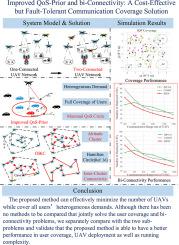UAV-BSs的容错三维拓扑构建,实现对不同QoS需求用户的全覆盖
IF 8
2区 计算机科学
Q1 COMPUTER SCIENCE, HARDWARE & ARCHITECTURE
引用次数: 0
摘要
在地面基础设施缺失或被破坏的灾后地区或战场部署无人机基站(UAV-BSs),可以快速恢复通信覆盖。由于环境的不稳定和敌对性质,应考虑保持UAV-BSs网络连通性的能力。在本文中,我们研究了部署UAV-BSs以实现对不同服务质量(QoS)需求的用户的全覆盖。目标是在用户需求和无人机- bs服务能力的约束下,使无人机- bs的数量最小化。此外,在没有地面基站的情况下,我们还致力于构建无人机- bs网络的双连通拓扑结构。然而,作为几何磁盘覆盖(GDC)问题的一个特例,公式化问题是np困难的。为了解决这一问题,我们提出了一种启发式算法,即改进QoS-Prior Coverage and bi-Connectivity (IQP2C),该算法分别解决用户覆盖和双连通拓扑结构子问题。首先,IQP2C以最少的覆盖无人机为用户提供全覆盖。然后,我们提出了一种基于高度簇的方法,从二维Hamilton循环扩展到构建UAV-BS网络的双连通性。仿真结果验证了IQP2C在满足不同QoS需求和构建容错拓扑方面的有效性。此外,IQP2C在用户覆盖的最小化UAV-BSs数量、双向连接的最小化UAV-BSs数量以及运行时间方面优于其他基准。本文章由计算机程序翻译,如有差异,请以英文原文为准。

Fault-tolerant 3-D topology construction of UAV-BSs for full coverage of users with different QoS demands
Deploying Unmanned aerial vehicle mounted base stations (UAV-BSs) in post-disaster areas or battlefields, where the ground infrastructures are missing or destroyed, can quickly restore communication coverage. Due to the unstable and hostile properties of the environments, the ability to maintain the connectivity of the UAV-BSs network should be considered. In this paper, we study the deployment of UAV-BSs to provide full coverage for users with different quality of service (QoS) demands. The objective is to minimize the number of UAV-BSs under the constraints of user demands and UAV-BS service abilities. Besides, in absence of ground base stations, we also aim to construct a bi-connected topology for the UAV-BS network. However, the formulated problem, as a special instance of the geometric disk cover (GDC) problem, is NP-hard. To tackle this problem, we propose a heuristic algorithm, named Improved QoS-Prior Coverage and bi-Connectivity (IQP2C), by separately solving the user coverage and bi-connected topology construction subproblems. Firstly, IQP2C provides full coverage for users with minimum covering UAVs. Then, we propose an altitude-cluster-based method extending from the 2-D Hamilton cycle to construct bi-connectivity for the UAV-BS network. Simulation results validate the effectiveness of IQP2C in meeting different QoS demands and constructing fault-tolerant topology. Moreover, IQP2C outperforms other baselines in terms of minimized number of UAV-BSs for user coverage, minimized number of UAV-BSs for bi-connectivity as well as running time.
求助全文
通过发布文献求助,成功后即可免费获取论文全文。
去求助
来源期刊

Journal of Network and Computer Applications
工程技术-计算机:跨学科应用
CiteScore
21.50
自引率
3.40%
发文量
142
审稿时长
37 days
期刊介绍:
The Journal of Network and Computer Applications welcomes research contributions, surveys, and notes in all areas relating to computer networks and applications thereof. Sample topics include new design techniques, interesting or novel applications, components or standards; computer networks with tools such as WWW; emerging standards for internet protocols; Wireless networks; Mobile Computing; emerging computing models such as cloud computing, grid computing; applications of networked systems for remote collaboration and telemedicine, etc. The journal is abstracted and indexed in Scopus, Engineering Index, Web of Science, Science Citation Index Expanded and INSPEC.
 求助内容:
求助内容: 应助结果提醒方式:
应助结果提醒方式:


